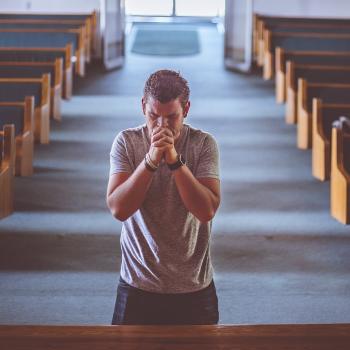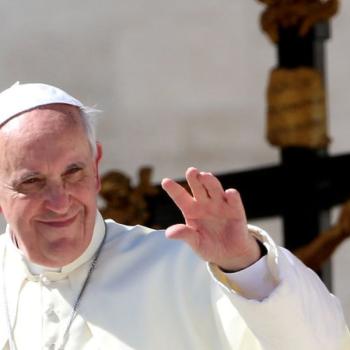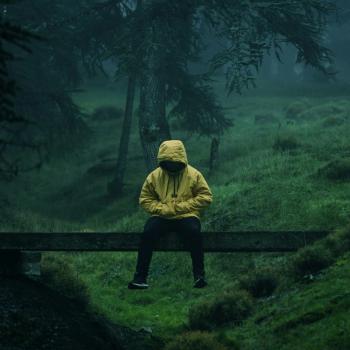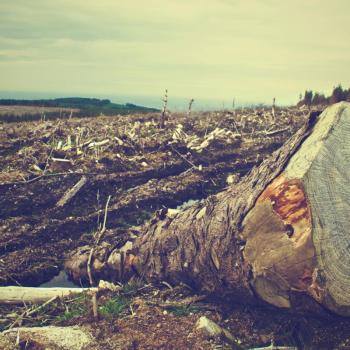The Asbury Revival may be over, but a hike on the Asbury Trails left me yearning for a revival of a different kind.
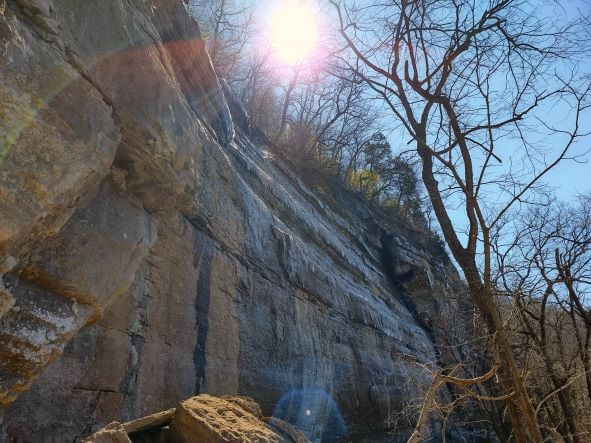
I live in Lexington, Kentucky, about a 30-minute drive from the small town of Wilmore, home to Asbury University. I first drove through the town in 2020 when I took my kids to the Asbury Trails, a mile-and-a-half hike through scenic woods along the towering palisades lining the Kentucky River. Located on 50 acres of ravines and bluffs about a mile from the town, the trails are owned by Asbury University and open to the public. We climbed the steep trails and marveled at the breathtaking rock formations. On the way home, we stopped in a little park in Wilmore to eat our picnic lunch.
Wilmore is a typical tiny, quiet, well-kept American town.
But on February 8th, 2023, that all changed for a period of more than two weeks. It began with a spontaneous gathering of college students who stayed to pray with each other after the weekly chapel service ended. The gathering grew at the rate of snowballing social media hits until thousands from across the U.S. were lining up to be part of the revival.
By all accounts, the students sustained an ongoing worship service of prayer, music, confession, Bible reading, and testimony through a genuine, heartfelt response to God’s Spirit and the love of Jesus Christ. Thomas Lyons wrote in The Atlantic, “People I have spoken with who entered these spaces describe encountering a ‘sweet presence,’ ‘deep peace,’ or ‘the quiet, heavy presence of God.’ A sense of awe prevails. It is, one participant told me, as if ‘heaven opened up.’”
The little town was overwhelmed with visitors hoping to catch the wave that the Holy Spirit was creating in those young adults. After two weeks and two days, the university ended the revival on Feb. 23rd. But the ripple effect continued on other college campuses from Texas to Tennessee and beyond.
At first, I hadn’t heard anything about the revival because I’m Lutheran, and that’s not a “thing” for us.
But friends from other parts of the country began asking me what I thought about what was happening at Asbury, knowing that I lived so close. Then I noticed that here in Lexington it became the talk of the town, like the way a major storm becomes the topic of everyday conversation.
Even though I teach at a seminary and am an ordained minister, I initially refrained from commenting on the Asbury Revival.
But I did follow the threads of discussion among my Lutheran colleagues wishing that our own denomination would experience such an outpouring of youthful spirit and devotion. In other threads and articles, people expressed suspicion and even disdain for what was happening on the campus of Asbury.
Some also noted that in this very white town and very white campus, the revival could be a dangerous feeder of white Christian Nationalism.
However, Lyons pointed out that “The leaders on the ground have turned away people seeking to co-opt the event. . . Christian nationalists who arrived toting their flags have been allowed to enter but told to leave their flags at the door—this is about Jesus, not America. No AR-15s or individuals dressed in flak jackets are present. Fox News’s Tucker Carlson was asked not to come to cover the revival, because it has nothing to do with politics or business. No one wants to pervert or disrupt what God is seemingly doing in this community.”
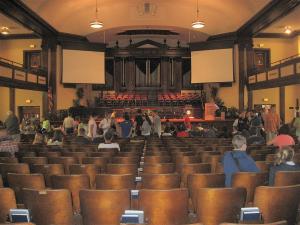
Nevertheless, Andre Henry, program manager for the Racial Justice Institute at Christians for Social Action, sounds a note of warning. “As revival meetings move away from Asbury’s campus, and continue to pop up around the country, the alleged outpouring of the Holy Spirit is liable to be co-opted by charismatic Christian nationalists, some of whom traveled to Kentucky to be part of the goings-on. Other pastors tweeted their support, trying to claim the young people’s fervor for white conservative ideals.”
I wanted to feel supportive of the Asbury Revival.
I understand the yearning for spiritual renewal and a revival of the church. And I’m no stranger to large gatherings of young people inspired by being together for worship, music, and inspiring messages of faith. I’ve taken youth groups to the ELCA Youth Gathering and have been moved to tears by the experience. (Read: A Thousand Points of Lutheran Light – 2018 ELCA Youth Gathering.)
But this past week, when I returned to the Asbury Trails to hike the palisades once again, I experienced a yearning for a revival of a different kind.
Climate weirding had goosed our area of central Kentucky with a string of unusually warm days in late February. This freak warming nudged spring flowers and trees to bud and flower prematurely. But in March, hard frosts returned, confusing humans, birds, and plants alike. Yet I hoped that the spring flowers for which the Asbury Trails are well-known might still be holding on.
So I drove through Wilmore after the crowds had gone, hoping to catch a different movement of the Spirit.
I was not disappointed.
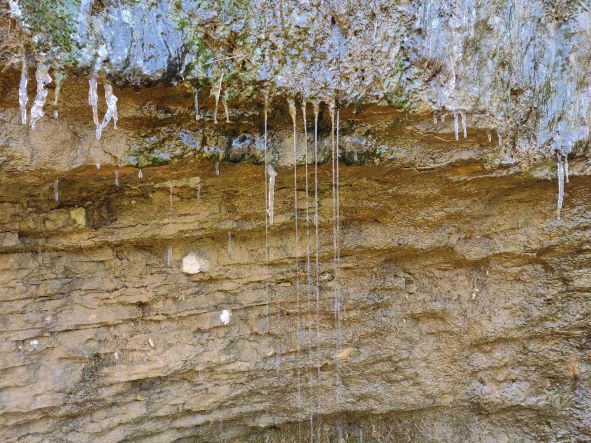
Here on the cusp of spring with ice dripping to form fantastic sculptures beneath the cliffs, tender and tenacious flowers claimed their time.
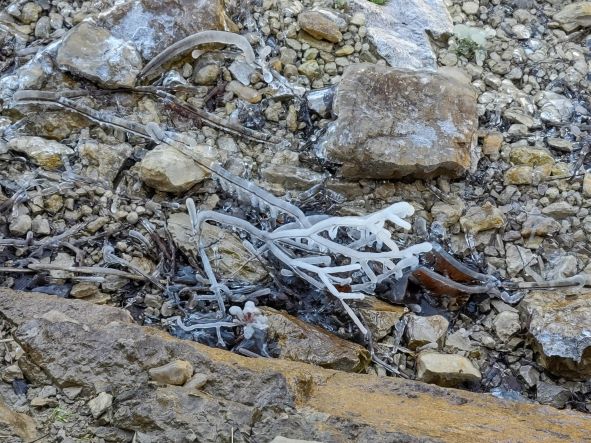
Mounds of white-flowered saxifrage clung to the icy cliffs with plucky courage.
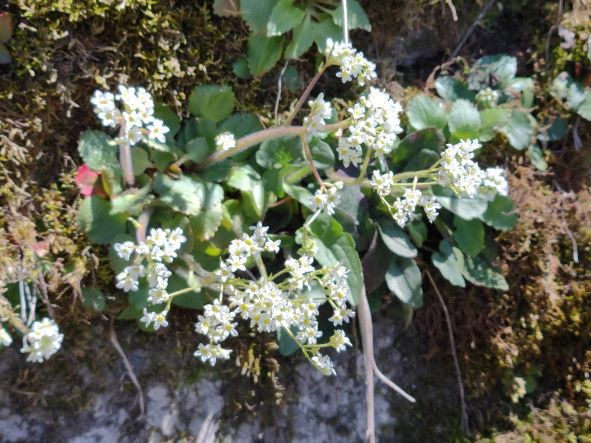
Virginia bluebell bravely blossomed beneath the green-sprayed trees. Purple sessile trillium pushed up through the cold forest ground.
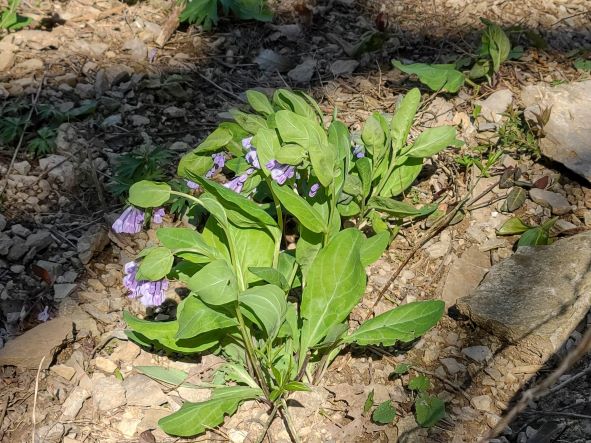
The Asbury Trails host some endangered species, many of which are furthered threatened by climate change.
70-degree days in February in Kentucky are not normal. Neither was the polar vortex that engulfed our state at Christmas plunging us into sub-zero windchills and causing pipes to burst, including in my own home. Then there was the flooding that happened in eastern Kentucky in the summer of 2022. And the tornadoes that struck western Kentucky the year before that.
The point I’m trying to make is that while I do not doubt the sincerity of those who were part of the Asbury Revival, nor do I doubt that the Spirit of God was present, I can’t help but yearn for a different kind of revival. I would have dearly loved to see these young people — who will bear the brunt of the fall-out from climate disruption – channel this energy into a revival for our planetary survival.
The energy of the Asbury Revival was directed inward toward personal piety, charismatic expressions of faith, and passion for religious zeal. In and of itself, this is not a problem. But if that’s all that comes from the Asbury Revival, then I fear an opportunity for deeper renewal for our species and our Earth kin will have been lost.
Patheos blogger, Tim Suttle, wrote that the Asbury Revival only served to “dissipate the energy of change” that was needed to reform Evangelicalism.
“American evangelicalism sits at an inflection point,” he said. “Prophetic voices calling for a confession of systemic racism, patriarchy, and Christian Nationalism are creating the kinds of pressures and tensions that often give rise to reform. The church could use this energy to foster prophetic renewal. If history is our teacher, what the church will do instead is have a revival, dissipate the energies of change, and continue down the road to self-destruction.”
I think Suttle may be correct. And I would add that it’s possible that the Asbury Revival also siphoned off precious energy from religious climate and environmental activism.
As I watched the steady stream of stories coming out of Wilmore about the young adults joined together in a spontaneous gathering inspired by the Holy Spirit, I longed for their youthful energy to be directed toward protecting God’s Creation.
Imagine.
Imagine if that group of Gen-Z young adults had moved out from Hughes Auditorium with prophetic messages calling on their elders in the Evangelical church to take action on the climate crisis. And to address the environmental racism that is killing communities of color. Even to confront the fossil fuel pharaohs that have simultaneously commodified and polluted the planet.
Suttle wrote, “Are there voices within the 2023 Asbury revival that could lead the church toward the embrace of prophetic change? I don’t know. I guess time will tell. I think it’s important to judge any revival the way Jesus judged most actions: according to how they impact those on the margins. If a revival isn’t good news for the marginalized, then it’s not good news, and it’s not reviving anything worth keeping.”
Andre Henry would likely concur. He notes that, “For the biblical prophets, the worshipping community’s comfort with injustice stands in contradiction to its religious fervor. That contradiction can only be undone when the worshipping community channels its sudden religious zeal into social action aimed at ending oppression.”
This oppression includes what is being done to vulnerable and marginalized communities by polluting industries that are ravaging our land, water, and air.
I have made the case that the margins include our Earth-kin. And communities of color that suffer from environmental racism. As well as our very atmosphere choked with greenhouse gases and pollution.
So, if the Asbury Revival has no impact on inspiring young Evangelicals to protect, heal, and advocate for God’s Creation, then I fear it was nothing more than a self-serving “spectacle,” to use Suttle’s description.
But I was not present for the Asbury Revival, and I cannot say if the Spirit is done yet.
I know that there are young Evangelicals who do, in fact, care deeply about God’s Creation and are working to protect it. Young Evangelicals for Climate Action is a thriving organization that is equipping and empowering youth and young adults “to love God and love our neighbors through bold, wholehearted, and faithful climate action in our church and community in order to create a more just, equitable, and loving world.” One of their alumni, Corina Newsome, has been a powerful voice for protecting the most vulnerable of God’s creatures and encourages young black students to consider careers in science.
Perhaps there were some students who took part in the Asbury Revival and felt the Spirit leading them to connect their faith and their love of God’s Creation in a more active way. That is my hope and prayer.
In the meantime, I want to point out that a different kind of revival happens at Asbury far from the crowds and the worship services in places built by human hands.
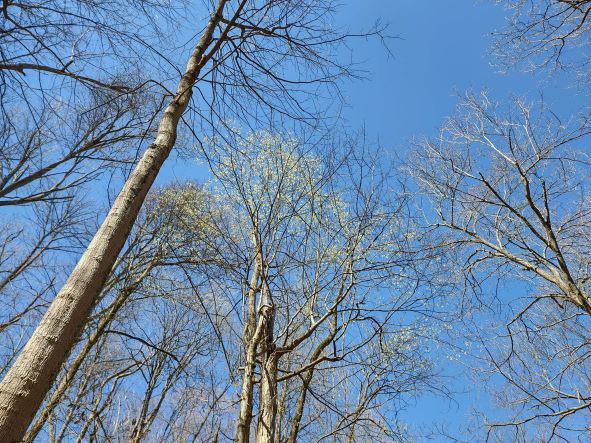
The congregation of trees along the ravine praise God in their own way, as the Bible teaches us. (You will indeed go out with joy and be peacefully guided; the mountains and the hills will break into singing before you, and all the trees of the field will clap their hands. Isaiah 55:13)
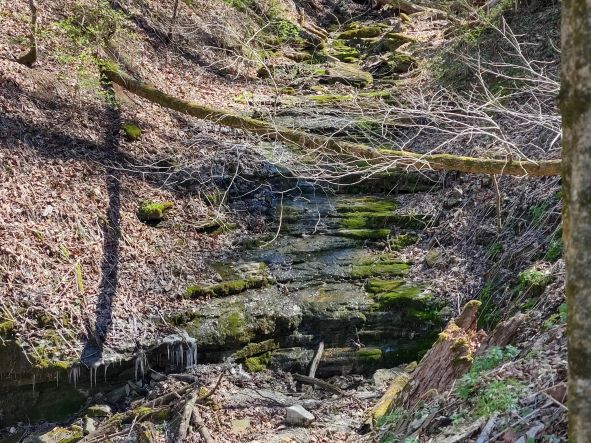
The birds and animals teach us about our Creator. (But ask the beasts, and they will teach you; the birds of the heavens, and they will tell you. Job 12:7.) And, as Jesus noted, even if the human voices are silenced, the stones will cry out in praise (Luke 19:40).
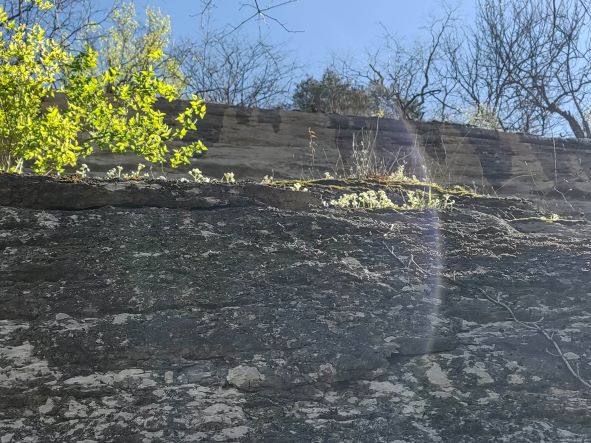
The song of the stones in the palisades are older than any of us. Theirs is a silent song sustained over millions of years that witnesses to a revival every season. And it invites us to join in quiet reverence, bold acclamation, courageous prophetic action, and steadfast trust.
“For God so loved the world . . .” John 3:16.
Read also:
Birds, Church, and Climate Change: Spotlight on Corina Newsome
God’s Creation PREACHES! Psalm 19 Links Nature and Torah
Gleaning, Youth Climate Strike, and Justice: Golden Apples in the Sun
We Need Climate Education in Schools: A High School Student Speaks Out

The Rev. Dr. Leah D. Schade is the Associate Professor of Preaching and Worship at Lexington Theological Seminary in Kentucky and ordained in the ELCA. Dr. Schade does not speak for LTS or the ELCA; her opinions are her own. She is the author of Preaching in the Purple Zone: Ministry in the Red-Blue Divide (Rowman & Littlefield, 2019) and Creation-Crisis Preaching: Ecology, Theology, and the Pulpit (Chalice Press, 2015). She is the co-editor of Rooted and Rising: Voices of Courage in a Time of Climate Crisis (Rowman & Littlefield, 2019). Her newest book is Introduction to Preaching: Scripture, Theology, and Sermon Preparation, co-authored with Jerry L. Sumney and Emily Askew (Rowman & Littlefield, 2023).






